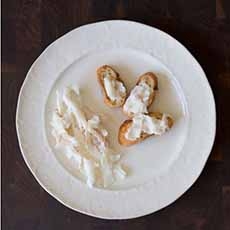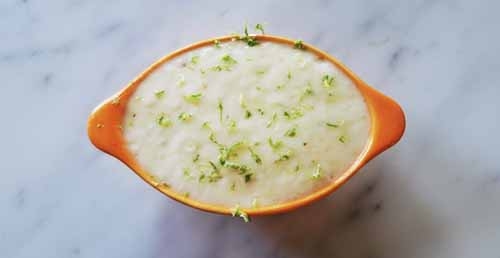
 A fine mortadella sausage, studded with jowl fat and pistachios. Available from DeLallo.com. A fine mortadella sausage, studded with jowl fat and pistachios. Available from DeLallo.com.
April 2010
Last Updated December 2025
|
 |
Cuts Of Pork
Pork Products Glossary Page 6: Lard, Mortadella & Other Pork Definitions With J To O
This is Page 6 of a nine-page glossary, including terms such as lard, lardo, loin of pork, and mortadella. Click on the black links below to visit other pages. See our many other food glossaries.
This glossary is protected by copyright and cannot be copied in whole or in part.
You are welcome to link to it.
Chart courtesy TheHealthyButcher.com. For a more detailed chart, see Page 1.
JAMÓN IBÉRICO or JAMÓN DE PATA NEGRA
Jamón ibérico de campo (jamón ibérico for short) is also known as jamón de pata Negro, ham of the black-hoof, from the black-hoofed Iberian pig (cerdo ibérico). There are three grades of jamón ibérico: pasture- and grain-fed jamón ibérico de campo; jamón ibérico de recebo, which is acorn, pasture, and corn-fed; and jamón ibérico de bellota, free-range and acorn-foraging, which can cost twice as much as a jamón ibérico de recebo. The ham is dry-cured for 24 months, and the product is a great luxury: The jamón ibérico de campo costs about $89.00 a pound, or $800 for a 9-pound boneless ham. This is the ham commonly served at tapas bars (and now you know why those slices are so thin!).
|
Pata negra only accounts for about 5% of total ham production in Spain. The best pigs are fattened (finished) by rooting free-range on acorns, in the cork oak groves along the southern border between Spain and Portugal. This is the famous (and famously expensive) jamón ibérico de bellota (acorn-fed Iberian ham). The physical activity in the forest creates a highly marbled meat with rich, golden fat that is full of antioxidants. This ham is cured for 36 months—a very long time, enabled by the high fat content and the antioxidant quality of the diet. Jamón ibérico de campo and jamón ibérico de recebo are still excellent hams, but not as spectacular as the bellota ham. Enjoy it is a first course with a side of warm toast. Read more about jamón ibérico. Also see ibérico pig and pata negra.
|
|

Jamón ibérico: in the front, sliced; in the rear, the entire leg. Photo courtesy LaTienda.com. |
JAMÓN SERRANO
See Serrano ham.
JOWL
The jowl is the jaw, particularly the lower jaw, of the animal. In pork, the term is often used to mean the cheek and jowl, but the areas are technically different. The cheek is the small portion of the face; the jowl is the big muscle that extends from the shoulder to the jawbone. Clarify with the butcher what you are getting. Cheeks tend to be less fatty and more meaty than jowls—a relative comparison, as both are extremely fatty cuts. The cheek is best braised or otherwise slow-cooked, or in a confit (make rillettes). The cured, unsmoked jowl is typically made into guanciale. The word “jowl” comes from the Middle English cholle, referring to the fold of flesh hanging from the jaw. In a pig, the jowl includes the cheek, although they can be sold separately.
LARD
Lard is the fat of the pig, in both rendered and unrendered forms. Lard is a solid fat; rendered lard is sold in bricks and tubs in supermarkets. Many cuisines use lard as a cooking fat or shortening, as well as a substitute spread instead of butter. Many bakers favor it over other fats because of the flakiness that results from the relatively large fat crystals (it produces flakier crusts than butter). Cooks like its relatively high smoke point (from its high saturated fatty acids content) because lard produces little smoke when heated and contributes its unique flavor to the dish.
|
During the 19th century, lard was used in a similar fashion as butter in North America and much of Europe. It was as popular as butter in the early 20th century and was widely used as a substitute during the butter shortage of World War II. Vegetable shortenings were developed in the early 1900s, which made it possible to use vegetable-based fats in baking and in other uses requiring solid fats. This led the way to the diminished use of lard, the saturated fat of which is an artery-clogger, leading to heart disease.
|
|

Lard. Photo courtesy Wikimedia. |
The irony is that lard has less saturated fat, less cholesterol, and more good unsaturated fat than an equal amount of butter by weight. Lard contains no trans fats, which many hydrogenated margarines and vegetable shortenings contained until health campaigns in 2006-2008 encouraged manufacturers to reformulate.
|
LARDO
Lardo is an Italian pork product made by curing pork fat with salt and herbs and spices (anise, garlic, rosemary, peppercorns, and others) that make it delicate and flavorful. Lardo di Colonnata, the original (and DOC-protected) lardo, is cured in marble tubs—an ingenious use for the large lard content of the pig as well as marble from the nearby Carrara quarries.
A cross-hatch of slits is made in the fat, and then rubbed with sea salt. The sides of the marble tub (conca di marmo) are rubbed with garlic; then layers of salt, herbs, and spices, followed by a layer of fat. The salt draws the water out of the fat, forming a brine. In its dehydrated state, the fat draws in the oils in the herbs.
Layers are alternated to fill the container, which is closed with a marble lid. The cure takes six months and produces an aromatic, soft, white, seasoned fat. The climate and the conca produce a unique product.
Lardo has been made for centuries and enjoyed as a sandwich spread by workers in the Carrera quarries.
|
|

Lardo. Photo courtesy MadeInCarrara.com.

Lardo is also rendered to serve as a spread (photo © Murray’s Cheese). |
It can be melted on a piece of toast instead of butter or served sliced thinly on warm toast as an antipasto. It can also be used to lard drier meats—turkey and pheasant breast, for example, or even a lean boned pork loin.

Lardo bread spread (photo © Broken Spanish | Los Angeles).
LARDON(S)
A French word for cubes of bacon that are fried. They are flavorful additions to salads and other dishes. “Lardon” also refers to strips of fat that are used to “lard” meat, to help keep it moist while it cooks.
LECHÓN
See suckling pig.
|
LIVER SAUSAGE or LIVERWURST
The pig’s liver is cooked (some are smoked), ground, well seasoned, and made into a fat sausage or loaf that’s ready to eat. It can be mixed with other meats, but must be at least 30% pork liver. The texture can range from firm enough to slice to creamy-smooth and spreadable. Fans enjoy it on crackers as a snack (it goes well with beer); some people make an appetizer pâté by blending the liver sausage with cream cheese and onion. It’s also popular as a sandwich: Use German rye or other rye bread, along with sliced onions.
|
|

Applewood-smoked liver sausage from Nueskes.com. |
|
LOIN OF PORK
The loin or back of the pork, the tenderest meat, is divided into the blade, center, and sirloin (see chart at top of page). These areas produce the premium cuts of the pig. The blade produces the blade roast. The center produces rib chops, loin chops, and the tenderloin, which runs from the center through the sirloin. The sirloin produces sirloin chops and sirloin roasts. The loin can be cured to produce Canadian bacon. It can also be further broken down into smaller roasts consisting of the blade loin (closest to the shoulder blade), the center loin roasts (from the center of the loin), and the sirloin roast (at the rear). Back ribs (aka baby back ribs), pork cutlet,s and pork chops can also be fabricated from the loin. Pork tenderloin, the most tender and popular portion of the entire pig, is found here as well. Because this is the most tender part of the big, it lends itself extraordinarily well to fast cooking methods such as grilling, roasting, and pan frying.
|
|

Raw pork loin available at Lobels.com.

Boneless stuffed loin of pork (see recipe) photo courtesy Seaboard Foods.
|
|
LOMO DI CERDO
Lomo is a dried ham made from jamón ibérico. Lomo means tenderloin, cerdo means hog; “cerdo” differentiates dried pork from dried beef. Lomo is cured with salt, garlic,c and pimentón (smoked paprika). The cured meat has a rich, smoky flavor and very little fat. It is typically served as a first course or appetizer, in thin slices with a drizzle the slices with olive oil.
|
|

Lomo from LaTienda.com. |
|
MORTADELLA
Originating in Bologna, Italy, mortadella is a large Italian sausage made of finely ground, heat-cured pork, which incorporates at least 15% small cubes of pork fat (principally jowl fat, the hard fat from the neck of the pig), plus sliced pistachio nuts. It is delicately flavored with spices, including whole or ground black pepper, myrtle berries, nutmeg, coriander, pistachios, and/or olives. While it is a sausage, it falls under the category of cold cuts, sandwich meats sliced thin and served cold.
MEXICAN CHORIZO
See chorizo.
|
|

Mortadella from DeLallo.com. |
|
OSSABAW PIG OR PORK
The hogs that evolved on Ossabaw Island, off the coast of Georgia, are descendants of Spanish Ibérico pigs brought to the New World in the 1500s. They were left on Ossabaw Island, one of the barrier reef islands, as a future food source. Feral for hundreds of years, the pigs were ultimately domesticated. They are smaller pigs with prick ears, heavy coats, and long snouts. Colors include black, spotted black and white, red, and tan. It is currently not possible to import the pigs directly from Ossabaw Island due to quarantine restrictions, but stock brought from the island to the mainland during the 1970s is available to individual breeders. As a very “lardy” pig, the breed is becoming more acclaimed for its delicious meat. However, as a smaller (less meat yield) and aggressive pig (it likes to bite people and kill birds), few breeders are up to the challenge. See heritage pork.
|
|

An Ossabaw pig. Note the woolly coat. Photo courtesy Wikimedia. |
Continue To Next Page: Pork Definitions P To R
Go To The Article Index Above
Lifestyle Direct, Inc. All rights reserved. Photos are the copyright of their respective owners.

|
















